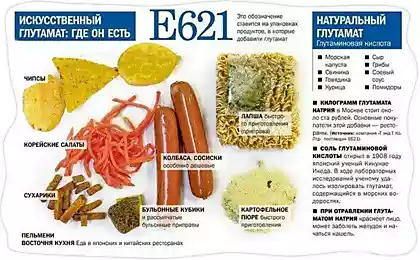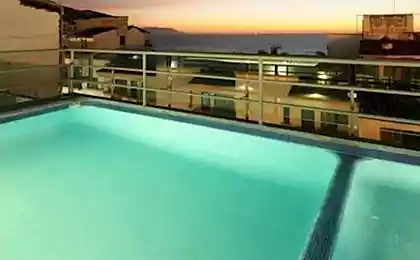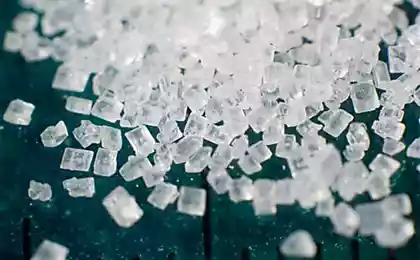473
Monosodium glutamate — myth and reality

About the dangers and benefits of this nutritional Supplement of its supporters and opponents argue themselves hoarse. What is the feature monosodium glutamate (E621), is it worth it to be afraid of and how it works?
In General, the lack of scientific explanation has not prevented people to use the benefits of MSG for more than two thousand years. Some confusion arose from the terminology: not everyone has a clear understanding of the fact that monosodium glutamate is a flavor enhancer.
It should be remembered that the taste enhancers improve the taste of food, but do some more intense taste sensations. The food industry calls them potentiating agents; I call them flavors. I must mention here that the question about the influence of monosodium glutamate on people who are sensitive to it, is still being discussed.
You've probably heard about "Chinese restaurant syndrome"? If not, let me remind you: this is the infamous (and moreover, politically incorrect) marking of a number of symptoms that were first described in 1968. We are talking about headache and burning sensation, appearing in some people after eating Chinese dishes. This notorious syndrome caused, as it turned out, it was monosodium glutamate. From that time began many years of fierce debate about whether this additive is dangerous to health or is it harmless.
On the one hand, the views of the national organization "Stop MSG" boils down to a simple decision, the essence of which is contained in the title. In other words, its supporters believe that monosodium glutamate in all its variations is at least twenty-three of the disease, starting with runny nose, bags under the eyes and panic attacks and up to partial paralysis. As you might guess, among the opponents of this view are the manufacturers of finished food and semi-finished products which MSG (and similar additives) are extremely valuable to attract consumers to their products.

The history of the emergence
A little bit about the history of the emergence of monosodium glutamate: it was first isolated from kombu seaweed by a Japanese chemist Kikunae Ikeda in 1908. The Japanese call it, Ajinomoto — "essence of taste" (or "the origins of taste"). In our time in the fifteen countries of the world annually produce 200 000 tons of pure monosodium glutamate.
Monosodium glutamate is a salt of glutamic acid, one of the most common amino acids from which proteins are built. Properties that enhance flavor, are in glutaminova part of the molecule, so any compound that produce free glutamate, may enhance the taste in the same way. Just MSG is the most concentrated and convenient form of glutamate.
Parmesan cheese, tomatoes, mushrooms, seaweed — all these foods are sources of glutamate. That's why even a small addition of any of these ingredients gives the dish a stronger taste.
The Japanese have long used the glutamate contained in seaweed, in the preparation of delicious soups. Our sense of taste is the result of very complex chemical and physiological reactions. Scientists find it difficult to determine exactly how this system responds to glutamate. However, there are several theories on this. It is known that molecules with different taste "stick" to the receptors on our taste the dermal papilla at different periods of time before disconnect. It is possible that glutamate cause certain molecules to stay longer, and thus we feel their taste is stronger. It is also possible that glutamate reacts a certain set of taste buds, different from the traditional receptors of sweet, bitter, sour and salty.
To further complicate the situation, it is worth mentioning that except for glutamate, there are other substances that can enhance the flavor. A long time ago the Japanese invented a word for the unique influence of algae for glutamate tastes umami. In our days this word represent a separate group of flavors that are stimulated glutamate, by analogy with the fact that there is a group of sweet taste sensations, stimulated by the sugar, aspartame and their "relatives" — sharename.
Many proteins contain glutamic acid, which can decompose to free glutamate in several ways, including bacterial fermentation and digestion process of a person.
The chemical decomposition reaction called hydrolysis, so that every time on the label, you will find "hydrolyzed protein" of any kind — vegetable, soy or yeast, is likely to have free glutamate. Hydrolyzed proteins are the most common as flavor enhancers in the finished products or semi-finished products. However, even if the food has no monosodium glutamate per se and on the label "no MSG", there may be other glutamate.
So if you are afraid that you belong to a group of people hypersensitive to glutamates, watch out for those terms on the labels of soups, vegetables and snacks, such as: hydrolyzed vegetable protein, autorizovany yeast protein, yeast extract, yeast nutrient, natural flavoring or flavoring agents.
So, what exactly is natural flavoring? It is a substance taken from a natural raw material and not created from scratch in a chemistry lab. That the substance called natural, not matter how complex was the chemical reaction resulted in a substance that causes a certain taste; the important thing is that these processes occurred without human intervention.
From the book: Robert wolke, Marlene Parrish. What Einstein told his cook. Moscow: Mann, Ivanov and Ferber, 2014.
источник:vokrugsveta.ru
Source: /users/1077























